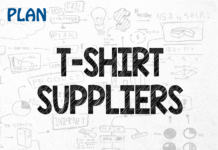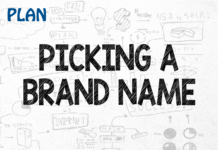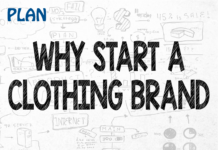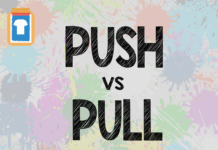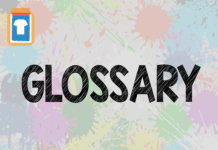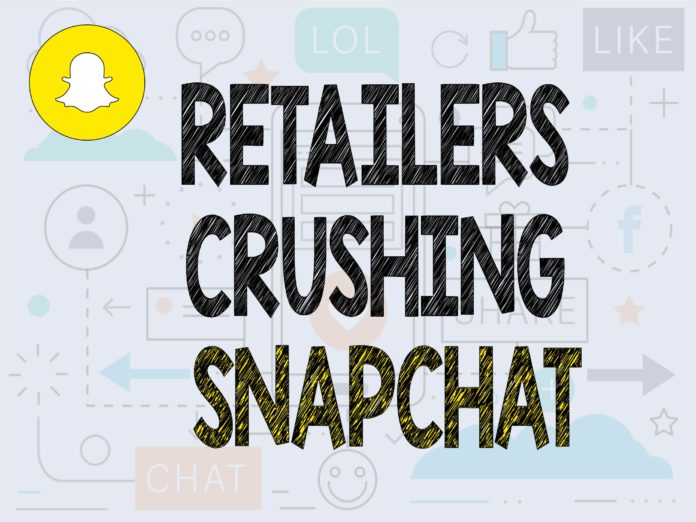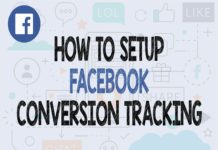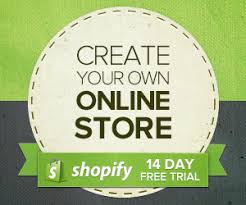Snapchat is both one of the scariest and one of the most exciting social media channels out there.
That’s probably why 92% of retailers are on Instagram, and only 47% have ventured on to Snapchat. Those numbers mean there’s lots of opportunity in the retail space to be an early adopter and leader with Snapchat marketing.
Michael Platco, Snapchat artist/storyteller/content creator/consultant/influencer, was one of the app’s first users. At first, he just sent silly doodles to his 13-year-old cousin. Now, global brands seek his expertise to help them with their Snapchat presence.
“Retailers don’t see the space as something they can truly capitalize on,” Platco says. “There’s a disconnect between getting people to convert.”
Why Brands Are Moving to Snapchat
While Snapchat’s limited analytics information make it nearly impossible to determine true ROI, there are definitely incentives for brands to have a presence.
The app has a user base of more than 200 million, a number that’s quickly catching up to Twitter and Pinterest. It’s especially popular among millennials, a demographic that marketers hope to better understand and influence. According to the platform, Snapchat reaches 41% of all 18-to-34-year-olds in the U.S. on any given day, and a whopping 71% of its users are under that benchmark age of 34.
With those kinds of usage stats, it makes sense that retailers would meet their customers where they’re hanging out online — particularly millennials, who have around $200 billion in annual buying power.
“If you’re not actively using the platform, you’re too far removed from understanding it,” Platco says.
We took a deeper look at what some of the few retailers on Snapchat do most effectively, and what other retailers can learn from them.
Wet Seal

Username: @wetseal
Who They Are
Wet Seal is a clothing retailer that offers economically priced apparel, footwear, and accessories targeted at teen girls and young women. They currently operate nearly 200 stores across the U.S.
Wet Seal on Snapchat
The key to Snapchat marketing for Wet Seal lies within their approach to influencer marketing. During the 2013 holiday season, they leveraged 16-year-old blogger MsMeghanMakeup to tap into her existing social audience of more than 300,000 and help promote the newly launched Wet Seal Snapchat account.
It was authentic in that Meghan was naturally already excited about the holiday season, an emotion that translated well on the platform. Through this campaign, Wet Seal added 9,000 followers in two weeks, and their Story was viewed more than 6,000 times in 24 hours — the most viewed brand story in Snapchat history at that time.
Her content wasn’t solely about Wet Seal. It was more about the holidays, with Wet Seal sprinkled in where it made sense. She went through her life for two days before Christmas, sharing normal teenage activities like playing with her dog and making holiday cookies. Wet Seal came into the story when Meghan shared her outfit of the day.
But Wet Seal didn’t limit all of its efforts to the influencer takeover. They also shared behind-the-scenes footage, in-store images and disappearing coupon codes on the channel.
Today, Wet Seal continues to work with influencers. They also share screenshots of images of their customers advocating for the brand.
Wet Seal’s efforts on the platform haven’t gone unnoticed. In 2014, they won for Snapchat in the 6th annual Shorty Awards.
Why it Works
Wet Seal was a pioneer of the channel. Their efforts have since guided best practices for brands on Snapchat.
The advantage for the retailer is that they were seen as innovative, yet casual and friendly to their consumers. Wet Seal demonstrated that they know and can relate to their audience — the trendy, fashion-forward teenage girl and young woman.
Snapchat is used by Wet Seal’s target audience, and they found an influencer who had already made headway in connecting with that audience. Their approach was highly targeted and personal.
Key Takeaways
Platco can testify to the effectiveness of this approach to Snapchat. “The only way to get new followers on Snapchat is to very specifically expose people that don’t already follow your Snapchat account. Takeovers will get brands new followers. It’s easy, there’s no QR code, and [users] don’t have to leave the app. It’s the most direct line to getting more followers.”
But the key is to remember that it’s not just a one-and-done kind of effort. “If you are going to use an influencer and you have no follow-up, that is a huge mistake. I see a lot of brands do it.”
Make sure you have a strategy in place to keep those new followers engaged after the influence takeover is over.
“[A brand has] invested a lot of money and effort into a project, event or launch. And then silence,” he says. “If you’re not creating content on Snapchat, you don’t exist on Snapchat. People are going to forget very quickly.”
Burberry
Username: @burberry
Who They Are
Burberry is a London-based luxury fashion retailer that sells accessories, outerwear, fragrances, and cosmetics. Their products are sold at Burberry stores worldwide, as well as at third-party retailers.
Burberry on Snapchat
Burberry employs a number of tactics on the channel, but perhaps its most innovative endeavor was the promotion of its fall/winter 2016 line. In a series of Snaps that would impress even a seasoned filmmaker, Burberry invested in the ultimate storytelling venture.
Essentially, the story followed two models who broke into the Burberry store on Regent Street in London. The two found items from the new collection and played dress-up with them in the store before being caught.
That’s not the first or the last of Burberry’s outside-the-box approach to leveraging the platform. It became the first luxury brand to sponsor a channel on the Discover tab of Snapchat for the promotion of new men’s fragrance Mr. Burberry. The concept was “how to be a modern man,” which Burberry told through grooming and style tips and content about the inspiration of the fragrance.
Burberry also sponsored a Snapchat Lens for women’s fragrance My Burberry Black in August 2016. The lens, which starred British model Lily James, was available for 24 hours in the U.S., U.K., France, Italy and Germany and was promoted on additional channels, including the Burberry Instagram account and in TV ad spots.
The fashion icon has run countless other campaigns on the social media messaging app. But their efforts aren’t limited to the mobile device. They also feature Snapchat QR code on tags for their products. Users can scan the code and gain instant access to content.
Why it Worked
Burberry is a premium, luxury brand — and their content aligns with this identity. The fashion brand didn’t enlist just anyone to create their video content. They hired Steve McQueen, award-winning director of 12 Years a Slave.
McQueen created content that wasn’t only engaging; It was memorable.
Burberry’s Snapchat works so well because they reach audiences in different ways: through the Discover channel (where those who don’t follow the brand can see the content), on their own Story, and through Lenses (where, again, those who don’t follow can engage with the content).
They also carefully promote their Snapchat efforts on other channels, as well as on the physical tags on certain products. This serves as a reminder of their presence on Snapchat, while doing so strategically so as not to bombard consumers and force the message upon them.
Key Takeaways
For many retailers, bridging the gap between the digital and in-store experiences is always a challenge. Platco commends Burberry’s approach to marrying the two. He recommends retailers think about when people would naturally use Snapchat while they’re in the store without being prompted to do so.
When people are in a clothing store, they take pictures of how they look, Platco says. Take a cue from the QR codes on product tags and look at other ways to incorporate it into your in-store experience. “I’ve seen brands put the QR code on every single receipt,” Platco says. “That’s genius.”
A challenge that brands face on Snapchat is lack of access to analytics. “You can’t really figure out how many followers you have. Apart from how many people view and screenshot your Story, there’s not much you can get out of Snapchat,” Platco explains.
“Geo-filters and Lenses [are] the only ways to get really good analytics from Snapchat about usage,” he says. So with Burberry’s My Burberry Black Lens, they were able to gather data about how many times the Lens was used and shared. This kind of information is every marketer’s dream, and it can provide strong insights into what works and what doesn’t.
Warby Parker
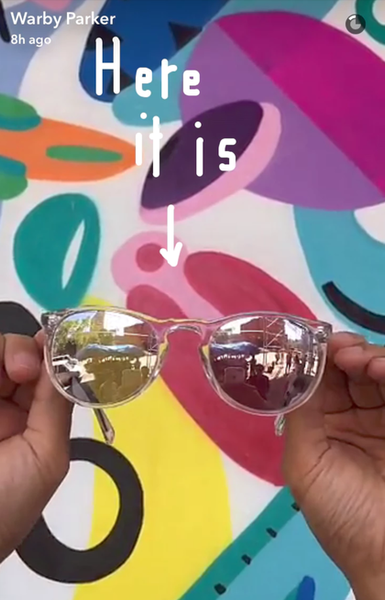
Username: @warbyparker
Who They Are
Warby Parker is an American brand of prescription eyeglasses and sunglasses. The company started as primarily an ecommerce brand in 2010, but has since opened just over 40 retail locations across the U.S. and in Toronto.
Warby Parker on Snapchat
Warby Parker is an example that hits close to home for Platco. The avid Warby Parker fan had his own meaningful interaction with the brand when traveling for work to Los Angeles from Boston one time.
Platco broke his glasses and decided to go for a temporary fix with super glue. In true Platco nature, he created a Snapchat Story about it, asking his audience for help figuring out how long it takes the glue to dry.
Within six hours, Warby Parker responded. “I had a Snapchat message and a tweet from Warby Parker that essentially said, ‘Hey Mike, we did the research. Super glue takes about four hours to dry. But this video should have the rest of the information.’”
The brand made a YouTube video specifically for Platco. They also looked into his customer profile and knew exactly the replacement pair he needed, shipping them out to him free of cost.
Focusing on customer service can turn these kinds of negative experiences into positive reviews (and repeat customers). Learn other customer service strategies with our free, curated list of high-impact tips.
But that story is just one isolated case. Warby Parker is effective in other ways on the channel for its larger audience.
The innovative brand released a sunglass product available only to their Snapchat followers. They promoted the product on their Snapchat along with a unique URL followers could go to purchase the sunglasses.
As far as regular maintenance of the channel, Snapchat offers tons of relevant content. They’ve explored places to sit and read in specific neighborhoods, shared employee workspaces in their Desk Job series, and offered behind-the-scenes looks at new showroom openings — just to name a few. Warby Parker also uses geo-filters and other social channels to promote their Snapchat presence.
Why it Worked
Warby Parker has an established, loyal, and engaged audience. Their pre-existing brand advocates works in their favor. If you’re a retailer and you have dedicated fans like Warby Parker, give them more of what they want and ways in which to continue to spread the word about your brand.
The retailer has become an expert at listening. They see who’s out there talking about their brand, and they promote those advocates.
Warby Parker even asks its followers what content they want to see. This not only ensures the content is relevant and meets audience expectations, but it makes the brand’s job of maintaining an editorial calendar a heck of a ot easier.
Key Takeaways
Platco says his experience “speaks to what is one of the best things retailers can be doing with Snapchat: engaging with their audience and starting a conversation.” This is where retailers need to be careful. Instead of speaking atyour followers, listen first and then speak with them.
“[Warby Parker] is very actively absorbing content of their fans and solicitors. They were watching and saw the opportunity to engage with me in a very unique and organic way,” he says. “Now I talk about it all the time.”
Another lesson learned: If you don’t know what kind of content your audience wants, just ask!
Sephora

Username: @sephorasnaps
Who They Are
Founded in France, Sephora is a beauty retailer that sells cosmetics, skincare, color, fragrance, body, “smilecare” and hair products. The retailer has a presence in 30 countries and 706 locations in the U.S. alone.
Sephora on Snapchat
Sephora regularly taps into the opportunity to create lenses and geo-filters.
Global lenses are essentially filters sponsored by the retailer that are accessible by users regardless of location. Unsurprisingly, these filters often create an instant makeover to the subject in the photo, a look similar to one you could achieve with their products.
Filters can also target specific locations. At Sephora locations, they may employ a geo-filter. Their existing audience, especially consumers visiting the store, may use the filter.
Sephora stretched their creativity even further with a shoppable Snapchat campaign, one of the first of its kind. The retailer used another app that integrates with Snapchat and allows users to create images that are clickable when saved as a screenshot.
Why it Worked
The retailer took advantage of a trend that already existed, placing itself within the conversation organically. Sephora’s customers typically purchase their products to look and feel good. Many Snapchat filters have a similar effect, making the product not only relatable but the tactic appealing to users as well.
For filters targeted at specific locations, Sephora targets places where they have a presence. “Sephora does that all the time. There are some brands that you just become familiar with being advocates of the retail geo filter use. You see them pop up if you’re within 100 yards of a Sephora.”
It’s also effective in that it can help capture foot traffic. Some people may not realize they’re near a location, but when they see the filter, they may be inclined to seek out the store and shop.
Key Takeaways
When approaching the idea of creating a lens or filter, think about your audience and what they’re already using. You don’t always need to reinvent the wheel. Sephora took a trend and twisted it to align to their brand and their product, while catering to their audience’s taste.
Sephora is very successful in putting more weight on content that’s engaging instead of self-promotion. “If you can do cool stuff with the geo-filters, it’s a passive but effective means of using Snapchat,” says Platco. It’s a way of starting the conversation.
How do you use Snapchat do promote your brand? Share your tips in the comments below.


